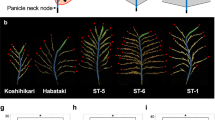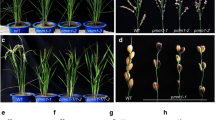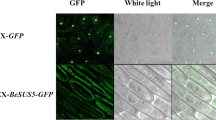Abstract
Panicle structure is one of the most important agronomic traits directly related to rice yield. This study identified a rice mutant basal primary branch 1 (bpb1), which exhibited a phenotype of reduced panicle length and arrested basal primary branch development. In addition, lignin content was found to be increased while cellulose content was decreased in bpb1 young panicles. Map-based cloning methods characterized the gene BPB1, which encodes a peptide transporter (PTR) family transporter. Phylogenetic tree analysis showed that the BPB1 family is highly conserved in plants, especially the PTR2 domain. It is worth noting that BPB1 is divided into two categories based on monocotyledonous and dicotyledonous plants. Transcriptome analysis showed that BPB1 mutation can promote lignin synthesis and inhibit cellulose synthesis, starch and sucrose metabolism, cell cycle, expression of various plant hormones, and some star genes, thereby inhibiting rice panicle length, resulting in basal primary branch development stagnant phenotypes. In this study, BPB1 provides new insights into the molecular mechanism of rice panicle structure regulation by BPB1 by regulating lignin and cellulose content and several transcriptional metabolic pathways.







Similar content being viewed by others

Data availability
The datasets generated during and/or analyzed during the current study are available from the corresponding author on reasonable request.
References
Ahmad I, X-p MENG, Kamran M, Shahzad A, Ahmad S, T-n LIU, Tie C, Q-f HAN (2020) Effects of uniconazole with or without micronutrient on the lignin biosynthesis, lodging resistance, and winter wheat production in semiarid regions. J Integr Agric 19(1):62–77. https://doi.org/10.1016/s2095-3119(19)62632-8
Ashikari M, Sakakibara H, Lin S, Yamamoto T, Takashi T, Nishimura A, Angeles ER, Qian Q, Kitano H, Matsuoka M (2005) Cytokinin oxidase regulates rice grain production. Science 309(5735):741–745. https://doi.org/10.1126/science.1113373
Chen Y, Dan Z, Gao F, Chen P, Fan F, Li S (2020) Rice GROWTH-REGULATING FACTOR7 modulates plant architecture through regulating GA and indole-3-acetic acid metabolism. Plant Physiol 184(1):393–406. https://doi.org/10.1104/pp.20.00302
Cho J-I, Ryoo N, Ko S, Lee S-K, Lee J, Jung K-H, Lee Y-H, Bhoo SH, Winderickx J, An G (2006) Structure, expression, and functional analysis of the hexokinase gene family in rice (Oryza sativa L.). Planta 224(3):598–611. https://doi.org/10.1007/s00425-006-0251-y
De Vleesschauwer D, Seifi HS, Filipe O, Haeck A, Huu SN, Demeestere K, Höfte M (2016) The DELLA protein SLR1 integrates and amplifies salicylic acid-and jasmonic acid-dependent innate immunity in rice. Plant Physiol 170(3):1831–1847. https://doi.org/10.1104/pp.15.01515
Duan J, Yu H, Yuan K, Liao Z, Meng X, Jing Y, Liu G, Chu J, Li J (2019) Strigolactone promotes cytokinin degradation through transcriptional activation of CYTOKININ OXIDASE/DEHYDROGENASE 9 in rice. Proc Natl Acad Sci 116(28):14319–14324. https://doi.org/10.1073/pnas.1810980116
Garg R, Verma M, Agrawal S, Shankar R, Majee M, Jain M (2014) Deep transcriptome sequencing of wild halophyte rice, Porteresia coarctata, provides novel insights into the salinity and submergence tolerance factors. DNA Res 21(1):69–84. https://doi.org/10.1093/dnares/dst042
González-Navarro OE, Griffiths S, Molero G, Reynolds MP, Slafer GA (2015) Dynamics of floret development determining differences in spike fertility in an elite population of wheat. Field Crop Res 172:21–31. https://doi.org/10.1016/j.fcr.2014.12.001
Gu B, Zhou T, Luo J, Liu H, Wang Y, Shangguan Y, Zhu J, Li Y, Sang T, Wang Z (2015) An-2 encodes a cytokinin synthesis enzyme that regulates awn length and grain production in rice. Mol Plant 8(11):1635–1650. https://doi.org/10.1016/j.molp.2015.08.001
Hao J, Wang D, Wu Y, Huang K, Duan P, Li N, Xu R, Zeng D, Dong G, Zhang B (2021) The GW2-WG1-OsbZIP47 pathway controls grain size and weight in rice. Mol Plant 14(8):1266–1280. https://doi.org/10.1016/j.molp.2021.04.011
He J, Liu Y, Yuan D, Duan M, Liu Y, Shen Z, Yang C, Qiu Z, Liu D, Wen P (2020) An R2R3 MYB transcription factor confers brown planthopper resistance by regulating the phenylalanine ammonia-lyase pathway in rice. Proc Natl Acad Sci 117(1):271–277. https://doi.org/10.1073/pnas.1902771116
Hirose T, Scofield GN, Terao T (2008) An expression analysis profile for the entire sucrose synthase gene family in rice. Plant Sci 174(5):534–543. https://doi.org/10.1016/j.plantsci.2008.02.009
Hu J, Zhu L, Zeng D, Gao Z, Guo L, Fang Y, Zhang G, Dong G, Yan M, Liu J (2010) Identification and characterization of NARROW AND ROLLED LEAF 1, a novel gene regulating leaf morphology and plant architecture in rice. Plant Mol Biol 73(3):283–292. https://doi.org/10.1007/s11103-010-9614-7
Huang J-W, Chen J-T, Yu W-P, Shyur L-F, Wang A-Y, Sung H-Y, Lee P-D, Su J-C (1996) Complete structures of three rice sucrose synthase isogenes and differential regulation of their expressions. Biosci Biotechnol Biochem 60(2):233–239. https://doi.org/10.1271/bbb.60.233
Huang P, Yoshida H, Yano K, Kinoshita S, Kawai K, Koketsu E, Hattori M, Takehara S, Huang J, Hirano K (2018) OsIDD2, a zinc finger and INDETERMINATE DOMAIN protein, regulates secondary cell wall formation. J Integr Plant Biol 60(2):130–143. https://doi.org/10.1111/jipb.12557
Huang L, Hua K, Xu R, Zeng D, Wang R, Dong G, Zhang G, Lu X, Fang N, Wang D (2021) The LARGE2-APO1/APO2 regulatory module controls panicle size and grain number in rice. Plant Cell 33(4):1212–1228. https://doi.org/10.1093/plcell/koab041
Hwang S-G, Chen H-C, Huang W-Y, Chu Y-C, Shii C-T, Cheng W-H (2010) Ectopic expression of rice OsNCED3 in Arabidopsis increases ABA level and alters leaf morphology. Plant Sci 178(1):12–22. https://doi.org/10.1016/j.plantsci.2009.09.014
Ikeda K, Sunohara H, Nagato Y (2004) Developmental course of inflorescence and spikelet in rice. Breed Sci 54(2):147–156. https://doi.org/10.1270/jsbbs.54.147
Jang S, Lee Y, Lee G, Seo J, Lee D, Yu Y, Chin JH, Koh H-J (2018) Association between sequence variants in panicle development genes and the number of spikelets per panicle in rice. BMC Genet 19(1):1–11. https://doi.org/10.1186/s12863-017-0591-6
Jiang Y, Bao L, Jeong SY, Kim SK, Xu C, Li X, Zhang Q (2012) XIAO is involved in the control of organ size by contributing to the regulation of signaling and homeostasis of brassinosteroids and cell cycling in rice. Plant J 70(3):398–408. https://doi.org/10.1111/j.1365-313x.2011.04877.x
Jin J, Shi J, Liu B, Liu Y, Huang Y, Yu Y, Dong A (2015) MORF-RELATED GENE702, a reader protein of trimethylated histone H3 lysine 4 and histone H3 lysine 36, is involved in brassinosteroid-regulated growth and flowering time control in rice. Plant Physiol 168(4):1275–1285. https://doi.org/10.1104/pp.114.255737
Jin L, Qin Q, Wang Y, Pu Y, Liu L, Wen X, Ji S, Wu J, Wei C, Ding B (2016) Rice dwarf virus P2 protein hijacks auxin signaling by directly targeting the rice OsIAA10 protein, enhancing viral infection and disease development. PLoS Pathogens 12(9):e1005847. https://doi.org/10.1371/journal.ppat.1005847
Jung H, Chung PJ, Park SH, Redillas MCFR, Kim YS, Suh JW, Kim JK (2017) Overexpression of Os ERF48 causes regulation of OsCML16, a calmodulin-like protein gene that enhances root growth and drought tolerance. Plant Biotechnol J 15(10):1295–1308. https://doi.org/10.1111/pbi.12716
Kim CM, Park SH, Je BI, Park SH, Park SJ, Piao HL, Eun MY, Dolan L, Han C-d (2007) OsCSLD1, a cellulose synthase-like D1 gene, is required for root hair morphogenesis in rice. Plant Physiol 143(3):1220–1230. https://doi.org/10.1104/pp.106.091546
Kumar M, Basha PO, Puri A, Rajpurohit D, Randhawa GS, Sharma TR, Dhaliwal HS (2010) A candidate gene OsAPC6 of anaphase-promoting complex of rice identified through T-DNA insertion. Funct Integr Genomics 10(3):349–358. https://doi.org/10.1007/s10142-009-0155-6
La H, Li J, Ji Z, Cheng Y, Li X, Jiang S, Venkatesh PN, Ramachandran S (2006) Genome-wide analysis of cyclin family in rice (Oryza sativa L.). Mol Genet Genom 275(4):374–386. https://doi.org/10.1007/s00438-005-0093-5
Li R, Xiong G, Zhou Y (2010) Membrane trafficking mediated by OsDRP2B is specific for cellulose biosynthesis. Plant Signal Behav 5(11):1483–1486. https://doi.org/10.4161/psb.5.11.13580
Li C, Liu Y, Shen WH, Yu Y, Dong A (2018) Chromatin-remodeling factor OsINO80 is involved in regulation of gibberellin biosynthesis and is crucial for rice plant growth and development. J Integr Plant Biol 60(2):144–159. https://doi.org/10.1111/jipb.12603
Li X, Shi S, Tao Q, Tao Y, Miao J, Peng X, Li C, Yang Z, Zhou Y, Liang G (2019) OsGASR9 positively regulates grain size and yield in rice (Oryza sativa). Plant Sci 286:17–27. https://doi.org/10.1016/j.plantsci.2019.03.008
Li S, Qian Q, Fu Z, Zeng D, Meng X, Kyozuka J, Maekawa M, Zhu X, Jian Z, Li J (2009) Short panicle1 encodes a putative PTR family transporter and determines rice panicle size. 58 (4):592–605. https://doi.org/10.1111/j.1365-313X.2009.03799.x
Lu Y, Meng Y, Zeng J, Luo Y, Feng Z, Bian L, Gao S (2020) Coordination between GROWTH-REGULATING FACTOR1 and GRF-INTERACTING FACTOR1 plays a key role in regulating leaf growth in rice. BMC Plant Biol 20(1):1–12. https://doi.org/10.1186/s12870-020-02417-0
Luan W, Liu Y, Zhang F, Song Y, Wang Z, Peng Y, Sun Z (2011) OsCD1 encodes a putative member of the cellulose synthase-like D sub-family and is essential for rice plant architecture and growth. Plant Biotechnol J 9(4):513–524. https://doi.org/10.1111/j.1467-7652.2010.00570.x
Miyamoto T, Takada R, Tobimatsu Y, Takeda Y, Suzuki S, Yamamura M, Osakabe K, Osakabe Y, Sakamoto M, Umezawa T (2019) OsMYB108 loss-of-function enriches p-coumaroylated and tricin lignin units in rice cell walls. Plant J 98(6):975–987. https://doi.org/10.1111/tpj.14290
Ohdan T, Francisco PB Jr, Sawada T, Hirose T, Terao T, Satoh H, Nakamura Y (2005) Expression profiling of genes involved in starch synthesis in sink and source organs of rice. J Exp Bot 56(422):3229–3244. https://doi.org/10.1093/jxb/eri292
Rösti S, Fahy B, Denyer K (2007) A mutant of rice lacking the leaf large subunit of ADP-glucose pyrophosphorylase has drastically reduced leaf starch content but grows normally. Funct Plant Biol 34(6):480–489. https://doi.org/10.1071/FP06257
Sakaguchi N, Furukawa T, Shimada H, Hashimoto J, Sakaguchi K, Umeda M (2006) Isolation and characterization of a rice cDNA encoding B1-type cyclin-dependent kinase. Plant Biotechnol 23(2):211–214. https://doi.org/10.5511/plantbiotechnology.23.211
Sakamoto T, Morinaka Y, Inukai Y, Kitano H, Fujioka S (2013) Auxin signal transcription factor regulates expression of the brassinosteroid receptor gene in rice. Plant J 73(4):676–688. https://doi.org/10.1111/tpj.12071
Satoh H, Shibahara K, Tokunaga T, Nishi A, Tasaki M, Hwang S-K, Okita TW, Kaneko N, Fujita N, Yoshida M (2008) Mutation of the plastidial α-glucan phosphorylase gene in rice affects the synthesis and structure of starch in the endosperm. Plant Cell 20(7):1833–1849. https://doi.org/10.1105/tpc.107.054007
Shen C, Wang S, Zhang S, Xu Y, Qian Q, Qi Y, Jiang DA (2013) OsARF16, a transcription factor, is required for auxin and phosphate starvation response in rice (Oryza sativa L.). Plant Cell Environ 36(3):607–620. https://doi.org/10.1111/pce.12001
Singh A, Jha SK, Bagri J, Pandey GK (2015) ABA inducible rice protein phosphatase 2C confers ABA insensitivity and abiotic stress tolerance in Arabidopsis. PloS One 10(4):e0125168. https://doi.org/10.1371/journal.pone.0125168
Song S, Wang G, Hu Y, Liu H, Bai X, Qin R, Xing Y (2018) OsMFT1 increases spikelets per panicle and delays heading date in rice by suppressing Ehd1, FZP and SEPALLATA-like genes. J Exp Bot 69(18):4283–4293. https://doi.org/10.1093/jxb/ery232
Su S, Hong J, Chen X, Zhang C, Chen M, Luo Z, Chang S, Bai S, Liang W, Liu Q (2021) Gibberellins orchestrate panicle architecture mediated by DELLA–KNOX signalling in rice. Plant Biotechnol J 19(11):2304–2318. https://doi.org/10.1111/pbi.13661
Su’udi M, Cha J-Y, Ahn I-P, Kwak Y-S, Woo Y-M, Son D (2012) Functional characterization of a B-type cell cycle switch 52 in rice (OsCCS52B). Plant Cell Tissue Organ Cult (PCTOC) 111(1):101–111. https://doi.org/10.1007/s11240-012-0176-z
Sun B, Zhan X-D, Lin Z-C, Wu W-X, Yu P, Zhang Y-X, Sun L-P, Cao L-Y, Cheng S-H (2017) Fine mapping and candidate gene analysis of qHD5, a novel major QTL with pleiotropism for yield-related traits in rice (Oryza sativa L.). Theor Appl Genet 130(1):247–258. https://doi.org/10.1007/s00122-016-2787-y
Tian X, Wang Z, Li X, Lv T, Liu H, Wang L, Niu H, Bu Q (2015) Characterization and functional analysis of pyrabactin resistance-like abscisic acid receptor family in rice. Rice 8(1):1–13. https://doi.org/10.1186/s12284-015-0061-6
Tseng I-C, Hong C-Y, Yu S-M, Ho T-HD (2013) Abscisic acid-and stress-induced highly proline-rich glycoproteins regulate root growth in rice. Plant Physiol 163(1):118–134. https://doi.org/10.1104/pp.113.217547
Umeda M, Umeda-Hara C, Yamaguchi M, Hashimoto J, Uchimiya H (1999) Differential expression of genes for cyclin-dependent protein kinases in rice plants. Plant Physiol 119(1):31–40. https://doi.org/10.1104/pp.119.1.31
Vydehi K, Gupta A (2011) RNAi mediated silencing of a wall associated kinase, OsiWAK1 in Oryza sativa results in impaired root development and sterility due to anther indehiscence. Physiol Mol Biol Plants 17(1):65–77. https://doi.org/10.1007/s12298-011-0050-1
Wang E, Wang J, Zhu X, Hao W, Wang L, Li Q, Zhang L, He W, Lu B, Lin H (2008) Control of rice grain-filling and yield by a gene with a potential signature of domestication. Nat Genet 40(11):1370–1374. https://doi.org/10.1038/ng.220
Wang S-H, Lim J-H, Kim S-S, Cho S-H, Yoo S-C, Koh H-J, Sakuraba Y, Paek N-C (2015) Mutation of SPOTTED LEAF3 (SPL3) impairs abscisic acid-responsive signalling and delays leaf senescence in rice. J Exp Bot 66(22):7045–7059. https://doi.org/10.1093/jxb/erv401
Wu Y, Wang Y, Mi X-F, Shan J-X, Li X-M, Xu J-L, Lin H-X (2016) The QTL GNP1 encodes GA20ox1, which increases grain number and yield by increasing cytokinin activity in rice panicle meristems. PLoS Genet 12(10):e1006386. https://doi.org/10.1371/journal.pgen.1006386
Xu Y, Hu D, Hou X, Shen J, Liu J, Cen X, Fu J, Li X, Hu H, Xiong L (2020) OsTMF attenuates cold tolerance by affecting cell wall properties in rice. New Phytol 227(2):498–512. https://doi.org/10.1111/nph.16549
Yonekura M, Aoki N, Hirose T, Onai K, Ishiura M, Okamura M, Ohsugi R, Ohto C (2013) The promoter activities of sucrose phosphate synthase genes in rice, OsSPS1 and OsSPS11, are controlled by light and circadian clock, but not by sucrose. Front Plant Sci 4:31. https://doi.org/10.3389/fpls.2013.00031
Yu C, Sun C, Shen C, Wang S, Liu F, Liu Y, Chen Y, Li C, Qian Q, Aryal B (2015) The auxin transporter, OsAUX1, is involved in primary root and root hair elongation and in Cd stress responses in rice (Oryza sativa L.). Plant J 83(5):818–830. https://doi.org/10.1111/tpj.12929
Yu H, Ren D, Zhu Y, Xu J, Wang Y, Liu R, Fang Y, Shi Z, Pan J, Lu M (2016) MULTI-TILLERING DWARF1, a new allele of BRITTLE CULM 12, affects plant height and tiller in rice. Sci Bull 61(23):1810–1817. https://doi.org/10.1007/s11434-015-0981-y
Yu X-l, Wang H-y, Leung DW, He Z-d, Zhang J-j, Peng X-x, Liu E (2019) Overexpression of OsIAAGLU reveals a role for IAA–glucose conjugation in modulating rice plant architecture. Plant Cell Rep 38(6):731–739. https://doi.org/10.1007/s00299-019-02402-4
Yuan H, Xu Z, Chen W, Deng C, Liu Y, Yuan M, Gao P, Shi H, Tu B, Li T (2022) OsBSK2, a putative brassinosteroid-signaling kinase, positively controls grain size in rice. J Exp Bot. https://doi.org/10.1093/jxb/erac222
Zhang H, T-t CHEN, L-j LIU, Z-q WANG, J-c YANG, J-h ZHANG (2013) Performance in grain yield and physiological traits of rice in the Yangtze River Basin of China during the last 60 yr. J Integr Agric 12(1):57–66. https://doi.org/10.1016/s2095-3119(13)60205-1
Zhang W, Sheng J, Xu Y, Xiong F, Wu Y, Wang W, Wang Z, Yang J, Zhang J (2019) Role of brassinosteroids in rice spikelet differentiation and degeneration under soil-drying during panicle development. BMC Plant Biol 19(1):1–16. https://doi.org/10.1186/s12870-019-2025-2
Zhang Y, Wang X, Luo Y, Zhang L, Yao Y, Han L, Chen Z, Wang L, Li Y (2020) OsABA8ox2, an ABA catabolic gene, suppresses root elongation of rice seedlings and contributes to drought response. Crop J 8(3):480–491. https://doi.org/10.1016/j.cj.2019.08.006
Zhang Z, Sun X, Ma X, Xu B, Zhao Y, Ma Z, Li G, Khan NU, Pan Y, Liang Y (2021) GNP6, a novel allele of MOC1, regulates panicle and tiller development in rice. Crop J 9(1):57–67. https://doi.org/10.1016/j.cj.2020.04.011
Zhou X, Liao H, Chern M, Yin J, Chen Y, Wang J, Zhu X, Chen Z, Yuan C, Zhao W (2018) Loss of function of a rice TPR-domain RNA-binding protein confers broad-spectrum disease resistance. Proc Natl Acad Sci 115(12):3174–3179. https://doi.org/10.1073/pnas.1705927115
Zhu G, Ye N, Zhang J (2009) Glucose-induced delay of seed germination in rice is mediated by the suppression of ABA catabolism rather than an enhancement of ABA biosynthesis. Plant Cell Physiol 50(3):644–651. https://doi.org/10.1093/pcp/pcp022
Zhu C, Bao X, Teng S, Deng C, Shen Z, Ai P, Lu T, Zhang S-w, Zhang Z (2021) OsRELA regulates leaf inclination by repressing the transcriptional activity of OsLIC in rice. Front Plant Sci 2181. https://doi.org/10.3389/fpls.2021.760041
Acknowledgements
The authors extend their appreciation to the support from Collaborative Innovation Center of Henan Grain Crops and Henan Key Laboratory of Rice Biology, Henan Agricultural University.
Funding
This work was supported by the Project Tackling of Key Scientific and Technical Problems of Henan (212102110284) and Key Scientific Research Projects of Colleges and Universities in Henan Province (23A210027), received grants from the Natural Science Foundation of Henan (212300410357) and the Special Fund for Henan Agriculture Research System (HARS-22–03-G3), and sponsored by Natural Science Foundation of Henan (232300421156).
Author information
Authors and Affiliations
Contributions
Fei Li conducted transcriptome analysis, generated the figures and tables, wrote the original draft, review, and editing. Ke Wang conducted most of the experiments, including genetic effect validation and fine mapping. Xiaohua Zhang and Peijie Han performed rice pericarp sampling, RNA extraction and qRT-PCR. Ye Liu prepared Fig. 5. Jing Zhang, Ting Peng, Junzhou Li, and Yafan Zhao review and editing. Hongzheng Sun reviewed, edited, and revised the manuscript. Yanxiu Du designed the experiments, supervision, funding acquisition, resources, review, and editing. All authors discussed and commented on the manuscript.
Corresponding authors
Ethics declarations
Ethics approval and consent to participate
Not applicable.
Ethics approval
All authors approved the submission.
Consent to participate
N/A.
Consent for publication
Yes.
Conflict of interest
The authors declare no competing interests.
Additional information
Publisher's note
Springer Nature remains neutral with regard to jurisdictional claims in published maps and institutional affiliations.
Supplementary Information
Below is the link to the electronic supplementary material.
Rights and permissions
Springer Nature or its licensor (e.g. a society or other partner) holds exclusive rights to this article under a publishing agreement with the author(s) or other rightsholder(s); author self-archiving of the accepted manuscript version of this article is solely governed by the terms of such publishing agreement and applicable law.
About this article
Cite this article
Li, F., Wang, K., Zhang, X. et al. BPB1 regulates rice (Oryza sative L.) panicle length and panicle branch development by promoting lignin and inhibiting cellulose accumulation. Mol Breeding 43, 41 (2023). https://doi.org/10.1007/s11032-023-01389-x
Received:
Accepted:
Published:
DOI: https://doi.org/10.1007/s11032-023-01389-x



